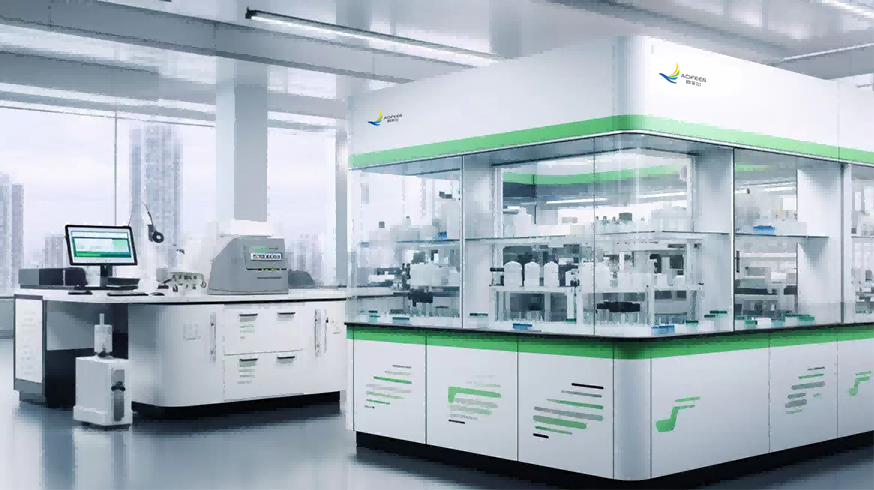As a rule of thumb,use a hood or other local ventilation device When working with any appreciably volatile substance with a TLV of less than 50 ppm
如在实验过程中,可能会使用任何易挥发物质且其挥发性最小阀值为50ppm(百万分率)时均应使用通风柜或其他局部排风设备。
Leave the hood'on'when it is not in active use it toxic substances are stored in it or if it is uncertain whether adequate general laboratory ventilation will be maintained When it is 'off
当通风柜内存放有挥发性或毒害性物质时.即使通风柜前无操作人员或通风柜为非使用状态或当通风柜关闭后,实验室整体排风无法确认能够充分保障实验室安全防护时,不得关闭通风柜。

In addition to protecting the laboratory worker from toxic or unpleasant agents used in them,fume hoods can provide an effective containment device for accidental spills of chemicals There should be at least one hood for every two workers in laboratories where most work involves hazardous chemicals,and the hoods should be large enough to provide each worker with at least 2.5 linear feet of working space at the face . If this amount of hood space is not available,other types of local ventilation should be provided,and speciai care should be exercised to monitor and restrict the use of hazardous substances
除了需保护实验室工作人员不受通风柜内所使用的有毒害或令人不适物质的侵害,通风柜还需提供在正常使用过程中,当化学物质发生偶然外溅时的防护功能。对于可能涉及有害化学物质的实验室,每两个操作人员需至少配备一台通风柜通风柜应该足够大以保证每个操作人员在通风柜前至少有2.5英尺(即0.8米)宽的工作区域。当这一条件未能满足时,则需配备其它类型的局部排风设备,且需特别注意监控和限制有害物质的使用。
Adequate laboratory fume hoods,special purpose hoods,or other engineering controls shall be used when there is a possibility of employee overexposure to air contaminants generated by a laboratory activity
当实验室操作人员有可能过多接触实验中产生的有害物质时.需使用合适的通风柜,万向罩或其它局部排风设备。
Many work practices might affect the overall safety and health in a laboratory
很多实验操作都可能会对实验室中的整体安全和卫生造成影响。
The following list concerns only those work practices that relate directly to hood performance and applies only when hazardous materials are to be used in the hood
下列内容仅包括可能直接影响通风柜性能的相关操作,且所有涉及危害物质的操作均在通风柜内进行。
The user shall not lean into the hood so that his/her head is inside the plane of the hood,as defined by the sash,without adequate respiratory and personal protection
使用者不应将身体倚靠通风柜而使他/她的头部进入到通风柜的调节窗内.这样会使他的呼吸和身体失去保护。
Equlpment and materials shall not be placed in the hood so that they block the slots or atherwise interfere with the smooth flow of air into the hood
设备和材料不应堆放入通风柜内.否则会堵塞气流,还会影响气流平缓流入通风柜。
All work shall be conducted at least 6 in .(15.2cm)behind the plane of the sash(hood face)
所有操作都应在通风柜调节窗后至少距离调节窗6英寸(即15.2厘米)处进行。
The horizontal sash or panels shall not be removed
不应把水平调节窗取下。
The hood shall not be operated without the back baffles in place
不应在导流板取下的情况下操作通风柜。
Flammable liquids shall not be stored permanently in the hood or the cabinet under the hood unless that cabinet meets the requirements of NFPA 30-2000 and NFPA 45-2000 for flammable liquid storage
可燃液体不得长期存储于通风柜或其下柜中除非该下柜符合NFPA30--2000和NFPA45-2000关于可燃液体存储的相关规定。
The sash or panels shall be closed to the maximum position possible While still allowing comfortable working conditions
在不影响操作的前提下,应尽可能将调节窗关至最小。
Hood users shall be trained to close the sash or panels when the hood is not in use
需培训操作人员让他在不使用通风柜时关闭调节窗
Rapid movement of the sash or panels shall be discouraged
不应快速移动调节窗。
Each hood shall be posted with a notice giving the date of the last periodic field test .If the hood failed the performance test,it shall be taken out of service until repaired.or posted with a restricted use notice
每台通风柜上需粘贴一张提示牌,注明上一次现场例行检测的日期如通风柜未能通过性能测试须中止使用直至修复或贴上限制使用的提示牌。
The notice shall state the partially closed sash position necessary for safe/normal operation and any other precaution concerning the type of work and materials permitted or prohibited
通风柜上需粘贴提示牌,注明调节窗需关至安全操作开度之下,以保障安全/正常运行,同时需提示关于允许或禁止的相关操作及使用物质等事项。
